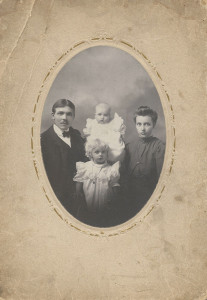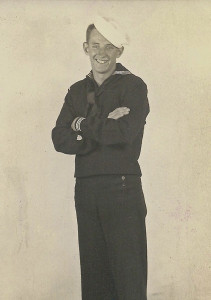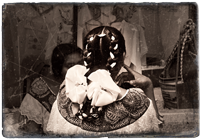A portrait of: Bernard James Fagan (b. 1923 Minco, OK – d. 2006 Rialto, CA)
And: Dorita Maria Guitierez-Cruz (b.1947, Las Nievas, Mexico – d. )
Bernard James Fagan, the great-great grandson of Michael & Biddy Fagan, was born in the town of Minco, Oklahoma, and was a survivor of the Dust Bowl. His parents were William “Chance” Fagan (b.1897 – d.1939) and Flossie Lee Colbert (b.1875 – d. ?). Chance and Flossie raised cattle on 160 acres of improved land owned by Chance’s father, Cornelius “Condy” Fagan (b. 1872 – d. 1943), who purchased the property in 1901, six years before Oklahoma became the 46th State.

Cornelius Condy Fagan (b.1872 – d.1943) taken 1887
This branch of the Fagan family ended up on the frontier shortly after Cornelius Fagan, following in his father’s footsteps, went to work for the Rock Island & Pacific Railway Company. Cornelius’ father John Fagan (b.1851 – d. 1908), the eldest son of Michael & Biddy Fagan, was a life-long railroad man who also worked for the Rock Island & Pacific Railway. He and his younger brother Edward (b.1856 – d.1876) started out together. John as a Fireman and Edward as a Switchman, hooking cars together, sometimes while they were still moving. Before automatic couplers were installed in the mid-1870s this was a dangerous position as railroads used link and pin couplers, which did not always align. John’s brother Edward was killed less than six months into his apprenticeship when he was crushed between two cars in a coupling accident in the Joliet Yard.
At 6 foot 6 inches and two hundred and sixty pounds, John was well suited for work as a Fireman, shoveling “black rock” from the tender to the firebox by hand at up to 200 pounds of coal per mile, depending on the freight load and the skill of the Engineer. As Fireman, John also monitored the water level in the boiler and kept the cylinders on the drive wheels oiled while the train was underway by climbing out on the running boards and creeping forward alongside the hot boilers to pour tallow on the valves. He knew that if he did his job well, in about three years’ time he would move up to Hostler, and then to Switch-engine Engineer before becoming a journeyman Engineer. John eventually achieved his goal and had his own Locomotive, #627, running freight and passengers from Joliet to Muscatine, Iowa. Ironically, several miles of the line ran directly parallel to and just a few yards from the Illinois & Michigan Canal that his father helped to build.

Condy & Rosemary Kennicott-Fagan, Abigail & Chance taken 1898
Cornelius admired his father’s work ethic greatly and with the help of his mentor secured a job in 1892 with the newly chartered Chicago, Rock Island and Texas Railway Company. Condy’s spirit for adventure landed the twenty year old in Indian Territory at the terminus of newly laid track at a place called Minco, an outpost whose only purpose was to serve as a gateway for shipping cattle. The Rock Island Railroad Co.’s original purpose in extending its line to Minco was to ship cattle by rail to the Stockyards in St. Louis and Chicago from the grazing lands of the Chickasaw Nation, just to the south of the town, putting an end to the famous cattle drives along the Chisholm Trail.
Condy met and married Rosemary Kennecott, the daughter of a railroad civil engineer, in 1893 shortly after his arrival in Minco. Condy began his tenure as a Switchman and by 1899 had worked his way up to Yardmaster. On August 4, 1901 the Chickasaw Nation’s land was opened to white settlement, and Condy Fagan purchased several parcels of land, correctly speculating that Oklahoma would soon become a state and Minco a railroad hub for the entire region. He sold all but 160 acres of his property and by 1917, at the age of 45, retired comfortably.
Cornelius’ son, William “Chance” Fagan and his Native American wife, Flossie Lee, said to be the grand daughter of Itawamba Minco, a Chickasaw Indian Chief and warrior and for whom the town was named, were married in 1921 and had five sons. Bernard was the third eldest. The family lived on the ranch with Chance’s parents, Condy & Rosemary. They grew wheat and maintained about 200 head of cattle. When the Stock Market crashed in 1929, the Fagans were able to sustain themselves the following year with a decade’s worth of bumper crops and all-time-high market prices for both wheat and beef cattle. But severe drought struck in 1931, stripping the ground of silage, and half of their herd died of thirst and starvation. The successive years of 1932 through 1934 brought increased, unrelenting, and suffocating dust storms. On May 9, 1934, a sudden two-day storm removed massive amounts of Great Plains topsoil in one of the worst storms of the Dust Bowl era. The black blizzard blotted out the sun, created giant drifts against their home, blew away the new crop they had just planted, and choked their remaining livestock to death. Clouds of dirt blew all the way to Chicago, depositing an estimated 12 million pounds of dust. Unable to pay their debts, the bank came and repossessed all the Fagan’s machinery, including the tractor, was repossessed by the bank, eliminating the last possible hope they had to keep them on the dust-ravaged land. With their home buried up to the window sills in fine dust, Chance’s parents, Condy and Rosemary abandoned their once-proud but now worthless ranch and moved to Oklahoma City. Chance and Flossie and their five boys had no choice but to load what belongings they could fit into their Ford pick-up truck and a small 2-wheeled trailer and move west. They joined the exodus of hundreds of thousands of other Americans displaced by the depression and the agricultural crisis that extended far beyond the southern plains, and met a river of refugees along Route 66 headed for California where both water and work were plentiful. They reached Needles, California on July 4th, 1934. Soon afterward they entered California’s central valley, which looked like the Garden of Eden compared to the endless brown of west-central Oklahoma, and settled in “Okietown” – Bakersfield. Chance went to work as a roughneck in the oil fields and died of a heart attack on an oilrig in 1939.

Bernard James Fagan c.1942
On December 8th, 1941, one day after the bombing of Pearl Harbor, 18 year-old Bernard Fagan enlisted for a three-year tour with the United States Navy. He received six weeks’ basic training in San Diego and soon afterward shipped out to Pearl Harbor. In April 1942 he became a Machinist’s Mate and served aboard the cruiser USS Salt Lake City. Bernard suffered shrapnel wounds in October of that year during the Sea Battle of Cape Esperance in the Solomon Islands. The Salt Lake City sustained three major hits from Japanese warships. Severely crippled, the ship was towed to the Allied forces military supply base on the island of Espiritu Santo for repairs. It was the first and last action Bernard Fagan saw during the war. He returned to Pearl Harbor aboard a make-shift hospital ship to recover and rehabilitate, later receiving orders to return to San Diego where he worked in the naval repair yard until he was honorably discharged as a petty officer 3rd Class in 1944. He returned briefly to his parent’s home in Bakersfield. His widowed mother Flossie Lee, decided to return to her native homeland in Oklahoma.
With his brothers gone and on their own, Bernard had no choice but to strike out on his own taking various odd jobs up and down the Golden State Highway throughout California’s Central Valley. In 1946 he took on work installing irrigation systems for the J. G. Boswell Company, the largest agricultural producer in the country.

Girl with ribbons in her hair from Las Nievas, Durango
During the latter part of WWII and for a brief period thereafter, U.S. growers convinced the Federal Government of on-going labor shortages in the fields and pushed for the expansion of the Bracero Program, the importation of agricultural laborers from Mexico. It is assumed that during this time (May-June 1946) Bernard began a brief relationship with a young Mexican migrant woman while constructing an irrigation weir down near Lake Success at Porterville. Her name was said to be Arminda Helena Gutierrez from Las Nievas, Durango. The women of this region of Mexico are noted for their elaborate and festive hair braids woven with fanciful ribbons. By the early 1960s Bernard was hauling produce in refrigerated tractor-trailer rigs to wholesale markets in Los Angeles, Sacramento, and the San Francisco Bay area. In 1971 he married Susan Sykes originally from Fresno. They were divorced in 1986. They had no children.

Dorita Maria Gutierrez-Cruz and her partner, Sylvia Alverez
Bernard died on May 1st, 2006, at Crestview Convalescent Hospital in Rialto, California. In his modest will he named fifty-nine year old Dorita Maria Gutierrez-Cruz of Sacramento, a former waitress at Wheezie’s Kitchen on Route 99 in Madera, California, as his sole beneficiary.
Read More
Rock Island & Pacific Railway Company
Chicago, Rock Island & Texas Railway Company
Chicago, Rock Island & Texas Railway Company 2

